Assessment of Emergy, Environmental and Economic Sustainability of the Mango Orchard Production System in Hainan, China
Abstract
1. Introduction
2. Methods
2.1. Case Study Description
2.2. Raw Data Sources
2.3. Emergy Evaluation
2.4. LCA Methodology
2.4.1. Goal and Scope Definition
2.4.2. Life Cycle Inventory (LCI)
2.4.3. Environmental Impact Assessment (LCIA)
2.5. Economic Analysis
3. Results
3.1. Emergy Evaluation
3.1.1. Emergy Structure Analysis
3.1.2. Emergy Index
3.2. LCA
3.2.1. Life Cycle Inventory Results
3.2.2. Environmental Impact Assessment Results
3.3. Economic Analysis
4. Discussion
4.1. Sustainability Analysis of Mango Cultivation Systems
4.2. The Key Factors Influencing Environmental Consequences
4.3. The Economic Consequences of the Mango Cultivation System
5. Conclusions
Supplementary Materials
Author Contributions
Funding
Institutional Review Board Statement
Informed Consent Statement
Data Availability Statement
Conflicts of Interest
References
- Li, Q.; Bu, J.; Shu, J.; Yu, Z.; Tang, L.; Huang, S.; Guo, T.; Mo, J.; Luo, S.; Solangi, G.S.; et al. Colletotrichum species associated with mango in southern China. Sci. Rep. 2019, 9, 18891. [Google Scholar] [CrossRef]
- Mo, J.; Zhao, G.; Li, Q.; Solangi, G.S.; Tang, L.; Guo, T.; Huang, S.; Hsiang, T. Identification and Characterization of Colletotrichum Species Associated with Mango Anthracnose in Guangxi, China. Plant Dis. 2018, 102, 1283–1289. [Google Scholar] [CrossRef]
- Ma, C.; Zhang, Q.; Liu, C.; Duan, Y. Analysis of multiple pesticide residues in mango of Hainan Province. Chin. J. Pestic. Sci. 2021, 23, 552–560. (In Chinese) [Google Scholar] [CrossRef]
- Zhu, J. Current situation, problems and development suggestions of Hainan mango industry. Agric. Eng. Technol. 2019, 39, 20–21. (In Chinese) [Google Scholar] [CrossRef]
- Guo, Z.; Sun, J.; Huang, X.; Zhong, H.; Zhu, Q. Variation characteristics of climate suitability of mango flowering period in changjiang. Chin. Agric. Sci. Bull. 2019, 35, 95–100. (In Chinese) [Google Scholar]
- Cerutti, A.K.; Beccaro, G.L.; Bruun, S.; Bosco, S.; Donno, D.; Notarnicola, B.; Bounous, G. Life cycle assessment application in the fruit sector: State of the art and recommendations for environmental declarations of fruit products. J. Clean. Prod. 2014, 73, 125–135. [Google Scholar] [CrossRef]
- Vásquez-Ibarra, L.; Iriarte, A.; Rebolledo-Leiva, R.; Vásquez, M.; Angulo-Meza, L.; González-Araya, M.C. Considering the influence of the variability in management practices on the environmental impacts of fruit production: A case study on raspberry production in Chile. J. Clean. Prod. 2021, 313, 127609. [Google Scholar] [CrossRef]
- Martin-Gorriz, B.; Gallego-Elvira, B.; Martínez-Alvarez, V.; Maestre-Valero, J.F. Life cycle assessment of fruit and vegetable production in the Region of Murcia (south-east Spain) and evaluation of impact mitigation practices. J. Clean. Prod. 2020, 265, 121656. [Google Scholar] [CrossRef]
- Han, J.; Jin, X.; Huang, S.; Zhu, X.; Liu, J.; Chen, J.; Zhang, A.; Wang, X.; Tong, Y.; Hussain, Q.; et al. Carbon and nitrogen footprints of apple orchards in China’s Loess Plateau under different fertilization regimes. J. Clean. Prod. 2023, 413, 137546. [Google Scholar] [CrossRef]
- Longo, S.; Mistretta, M.; Guarino, F.; Cellura, M. Life Cycle Assessment of organic and conventional apple supply chains in the North of Italy. J. Clean. Prod. 2017, 140, 654–663. [Google Scholar] [CrossRef]
- Amiri, Z.; Asgharipour, M.R.; Campbell, D.E.; Sabaghi, M.A. Comparison of the sustainability of mechanized and traditional rapeseed production systems using an emergy-based production function: A case study in Lorestan Province, Iran. J. Crop Prod. 2020, 258, 120891. [Google Scholar] [CrossRef]
- Carneiro, J.M.; Dias, A.F.; Barros, V.d.S.; Giongo, V.; Matsuura, M.I.d.S.F.; de Figueirêdo, M.C.B. Carbon and water footprints of Brazilian mango produced in the semiarid region. Int. J. Life Cycle Assess. 2018, 24, 735–752. [Google Scholar] [CrossRef]
- Vinyes, E.; Gasol, C.M.; Asin, L.; Alegre, S.; Muñoz, P. Life Cycle Assessment of multiyear peach production. J. Clean. Prod. 2015, 104, 68–79. [Google Scholar] [CrossRef]
- Goossens, Y.; Annaert, B.; De Tavernier, J.; Mathijs, E.; Keulemans, W.; Geeraerd, A. Life cycle assessment (LCA) for apple orchard production systems including low and high productive years in conventional, integrated and organic farms. Agric. Syst. 2017, 153, 81–93. [Google Scholar] [CrossRef]
- Sales, H.; Figueiredo, F.; Vaz Patto, M.C.; Nunes, J. Assessing the environmental sustainability of Portuguese olive growing practices from a life cycle assessment perspective. J. Clean. Prod. 2022, 355, 131692. [Google Scholar] [CrossRef]
- Cabot, M.I.; Lado, J.; Sanjuán, N. Multi-season environmental life cycle assessment of lemons: A case study in south Uruguay. J. Environ. Manag. 2023, 326, 116719. [Google Scholar] [CrossRef] [PubMed]
- Cheng, H.; Hu, W.; Zhou, X.; Dong, R.; Liu, G.; Li, Q.; Zhang, X. Fruit Tree Legume Herb Intercropping Orchard System Is an Effective Method to Promote the Sustainability of Systems in a Karst Rocky Desertification Control Area. Forests 2022, 13, 1536. [Google Scholar] [CrossRef]
- Pérez, R.; Laca, A.; Laca, A.; Díaz, M. Environmental behaviour of blueberry production at small-scale in Northern Spain and improvement opportunities. J. Clean. Prod. 2022, 339, 130594. [Google Scholar] [CrossRef]
- Zhu, Z.; Jia, Z.; Peng, L.; Chen, Q.; He, L.; Jiang, Y.; Ge, S. Life cycle assessment of conventional and organic apple production systems in China. J. Clean. Prod. 2018, 201, 156–168. [Google Scholar] [CrossRef]
- Gaspar, P.D.; Godina, R.; Barrau, R. Influence of Orchard Cultural Practices during the Productive Process of Cherries through Life Cycle Assessment. Processes 2021, 9, 1065. [Google Scholar] [CrossRef]
- Wang, J.; Zhao, M.; Wan, Y.; Zeng, Y.; Wei, Y.; Zhang, Y.; Chen, X.; Shi, X. Environmental Assessment of Furrow vs. Drip Irrigated Pear (Pyrus bretschneideri Rehd.) Production Systems in Loess Plateau (China). Agronomy 2021, 11, 1201. [Google Scholar] [CrossRef]
- Odum, H.T. Environmental Accounting-EMERGY and Environmental Decision Making; Wiley: New York, NY, USA, 1996. [Google Scholar]
- Brown, M.T.; Ulgiati, S. Emergy assessment of global renewable sources. Ecol. Model. 2016, 339, 148–156. [Google Scholar] [CrossRef]
- Wang, X.; Dadouma, A.; Chen, Y.; Sui, P.; Gao, W.; Jia, L. Sustainability evaluation of the large-scale pig farming system in North China: An emergy analysis based on life cycle assessment. J. Clean. Prod. 2015, 102, 144–164. [Google Scholar] [CrossRef]
- Xu, Q.; Wang, X.; Xiao, B.; Hu, K. Rice-crab coculture to sustain cleaner food production in Liaohe River Basin, China: An economic and environmental assessment. J. Clean. Prod. 2019, 208, 188–198. [Google Scholar] [CrossRef]
- Hosseini-Fashami, F.; Motevali, A.; Nabavi-Pelesaraei, A.; Hashemi, S.J.; Chau, K.W. Energy-Life cycle assessment on applying solar technologies for greenhouse strawberry production. Renew. Sust. Energ. Rev. 2019, 116, 109411. [Google Scholar] [CrossRef]
- Zhen, H.; Qiao, Y.; Ju, X.; Hashemi, F.; Knudsen, M.T. Organic conversion tea farms can have comparable economic benefits and less environmental impacts than conventional ones-A case study in China. Sci. Total Environ. 2023, 877, 162698. [Google Scholar] [CrossRef]
- Cheng, H.; Zhou, X.; Yang, Y.; Xu, L.; Ding, Y.; Yan, T.; Li, Q. Environmental damages, cumulative exergy demand, and economic assessment of Panus giganteus farming with the application of solar technology. Sci. Total Environ. 2024, 907, 168020. [Google Scholar] [CrossRef]
- Rugani, B.; Benetto, E. Improvements to Emergy Evaluations by Using Life Cycle Assessment. Environ. Sci. Technol. 2012, 46, 4701–4712. [Google Scholar] [CrossRef]
- Asgharipour, M.R.; Amiri, Z.; Campbell, D.E. Evaluation of the sustainability of four greenhouse vegetable production ecosystems based on an analysis of emergy and social characteristics. Ecol. Model. 2020, 424, 109021. [Google Scholar] [CrossRef]
- Xu, Y.; Li, P.; Gao, Y.; Li, Y.; Li, S.; Li, Y.; Sui, P.; Wang, X.; Gao, W.; Chen, Y. Sustainability evaluation for a circular maize-pig system driven by indigenous microbes: A case study in Northeast China. Ecosyst. Health Sustain. 2022, 8, 2080591. [Google Scholar] [CrossRef]
- Zhou, X.; Zheng, X.; Bu, L.; Yang, Y.; Xu, L.; Ding, Y.; Li, Q.; Cheng, H. Emergy, environmental impact, and economic assessment of rubber–edible mushroom–vegetable intercropping in Hainan, China. Ind. Crop. Prod. 2025, 231, 121172. [Google Scholar] [CrossRef]
- Chen, Y.; Liu, C.; Chen, J.; Hu, N.; Zhu, L. Evaluation on environmental consequences and sustainability of three rice-based rotation systems in Quanjiao, China by an integrated analysis of life cycle, emergy and economic assessment. J. Clean. Prod. 2021, 310, 127493. [Google Scholar] [CrossRef]
- Dias, A.F.; Giongo, V.; Barros, V.d.S.; Carneiro, J.M.; de Figueirêdo, M.C.B. An agile approach for evaluating the environmental-economic performance of cropping systems at experimental stage: The case of Brazilian mango. Int. J. Life Cycle Assess. 2020, 25, 1588–1604. [Google Scholar] [CrossRef]
- Wang, Z.; Wubshet, T.T.; Chen, H.; Wu, L.; Yang, H.; Yang, J.; Goldberg, S.D.; Xu, J.; Gui, H. Effects of degraded grassland conversion to mango plantation on soil CO2 fluxes. Appl. Soil Ecol. 2021, 167, 104045. [Google Scholar] [CrossRef]
- Nickia, G.M. The environmental pressures of eating a mango: A preliminary life cycle assessment of mango production in Taiwan. In Proceedings of the A&WMA’s 109th Annual Conference & Exhibition, New Orleans, LA, USA, 20–23 June 2016. [Google Scholar]
- Robinson, B.; Winans, K.; Kendall, A.; Dlott, J.; Dlott, F. A life cycle assessment of Agaricus bisporus mushroom production in the USA. Int. J. Life Cycle Assess. 2019, 24, 456–467. [Google Scholar] [CrossRef]
- Statistical Bureau of Hainan Province. Hainan Statistical Yearbook; China Statistics Press: Beijing, China, 2024.
- Brown, M.T.; Campbell, D.E.; De Vilbiss, C.; Ulgiati, S. The geobiosphere emergy baseline: A synthesis. Ecol. Model. 2016, 339, 92–95. [Google Scholar] [CrossRef]
- Asgharipour, M.R.; Shahgholi, H.; Campbell, D.E.; Khamari, I.; Ghadiri, A. Comparison of the sustainability of bean production systems based on emergy and economic analyses. Environ. Monit. Assess. 2019, 191, 2. [Google Scholar] [CrossRef]
- Amiri, Z.; Asgharipour, M.R.; Campbell, D.E.; Azizi, K.; Kakolvand, E.; Moghadam, E.H. Conservation agriculture, a selective model based on emergy analysis for sustainable production of shallot as a medicinal-industrial plant. J. Clean. Prod. 2021, 292, 126000. [Google Scholar] [CrossRef]
- ISO 14040; Environmental Managementd–Life Cycle Assessment–Principles and Framework. ISO: Geneva, Switzerland, 2006.
- Huijbregts, M.A.J.; Steinmann, Z.J.N.; Elshout, P.M.F.; Stam, G.; Verones, F.; Vieira, M.; Zijp, M.; Hollander, A.; van Zelm, R. ReCiPe2016: A harmonised life cycle impact assessment method at midpoint and endpoint level. Int. J. Life Cycle Assess. 2016, 22, 138–147. [Google Scholar] [CrossRef]
- Zhen, H.; Gao, W.; Jia, L.; Qiao, Y.; Ju, X. Environmental and economic life cycle assessment of alternative greenhouse vegetable production farms in peri-urban Beijing, China. J. Clean. Prod. 2020, 269, 122380. [Google Scholar] [CrossRef]
- Nan, B.; Li, B.; Yang, Z.; Dai, X.; Fan, Y.; Fu, Q.; Hao, L.; Zhang, X. Sustainability of sown systems of cultivated grassland at the edge of the Junggar Desert Basin: An integrated evaluation of emergy and economics. J. Clean. Prod. 2020, 276, 122800. [Google Scholar] [CrossRef]
- Cui, J.; Yan, P.; Wang, X.; Yang, J.; Li, Z.; Yang, X.; Sui, P.; Chen, Y. Integrated assessment of economic and environmental consequences of shifting cropping system from wheat-maize to monocropped maize in the North China Plain. J. Clean. Prod. 2018, 193, 524–532. [Google Scholar] [CrossRef]
- Houshyar, E.; Wu, X.F.; Chen, G.Q. Sustainability of wheat and maize production in the warm climate of southwestern Iran: An emergy analysis. J. Clean. Prod. 2018, 172, 2246–2255. [Google Scholar] [CrossRef]
- Bessou, C.; Basset-Mens, C.; Tran, T.; Benoist, A. LCA applied to perennial cropping systems: A review focused on the farm stage. Int. J. Life Cycle Assess. 2013, 18, 340–361. [Google Scholar] [CrossRef]
- Cerutti, A.K.; Bruun, S.; Donno, D.; Beccaro, G.L.; Bounous, G. Environmental sustainability of traditional foods: The case of ancient apple cultivars in Northern Italy assessed by multifunctional LCA. J. Clean. Prod. 2013, 52, 245–252. [Google Scholar] [CrossRef]
- Zhao, C.; Gao, B.; Wang, L.; Huang, W.; Xu, S.; Cui, S. Spatial patterns of net greenhouse gas balance and intensity in Chinese orchard system. Sci. Total Environ. 2021, 779, 146250. [Google Scholar] [CrossRef] [PubMed]
- Basset-Mens, C.; Vannière, H.; Grasselly, D.; Heitz, H.; Braun, A.; Payen, S.; Koch, P.; Biard, Y. Environmental impacts of imported and locally grown fruits for the French market: A cradle-to-farm-gate LCA study. Fruits 2016, 71, 93–104. [Google Scholar] [CrossRef]
- Jafari, M.; Asgharipour, M.R.; Ramroudi, M.; Galavi, M.; Hadarbadi, G. Sustainability assessment of date and pistachio agricultural systems using energy, emergy and economic approaches. J. Clean. Prod. 2018, 193, 642–651. [Google Scholar] [CrossRef]
- Guo, Y.H.; Wang, H.; Zhang, W.; Chen, B.; Song, D. Sustainability evaluation of protected vegetables production in China based on emergy analysis. J. Clean. Prod. 2023, 388, 135928. [Google Scholar] [CrossRef]
- Alaphilippe, A.; Boissy, J.; Simon, S.; Godard, C. Environmental impact of intensive versus semi-extensive apple orchards: Use of a specific methodological framework for Life Cycle Assessments (LCA) in perennial crops. J. Clean. Prod. 2016, 127, 555–561. [Google Scholar] [CrossRef]
- Mostashari-Rad, F.; Ghasemi-Mobtaker, H.; Taki, M.; Ghahderijani, M.; Kaab, A.; Chau, K.-W.; Nabavi-Pelesaraei, A. Exergoenvironmental damages assessment of horticultural crops using ReCiPe2016 and cumulative exergy demand frameworks. J. Clean. Prod. 2021, 278, 123788. [Google Scholar] [CrossRef]
- Cheng, J.; Wang, Q.; Li, D.; Yu, J. Comparative Analysis of Environmental and Economic Performance of Agricultural Cooperatives and Smallholder Farmers for Apple Production in China. Agriculture 2022, 12, 1281. [Google Scholar] [CrossRef]
- Svanes, E.; Johnsen, F.M. Environmental life cycle assessment of production, processing, distribution and consumption of apples, sweet cherries and plums from conventional agriculture in Norway. J. Clean. Prod. 2019, 238, 117773. [Google Scholar] [CrossRef]
- Hesampour, R.; Taki, M.; Fathi, R.; Hassani, M.; Halog, A. Energy-economic-environmental cycle evaluation comparing two polyethylene and polycarbonate plastic greenhouses in cucumber production (from production to packaging and distribution). Sci. Total Environ. 2022, 828, 154232. [Google Scholar] [CrossRef] [PubMed]
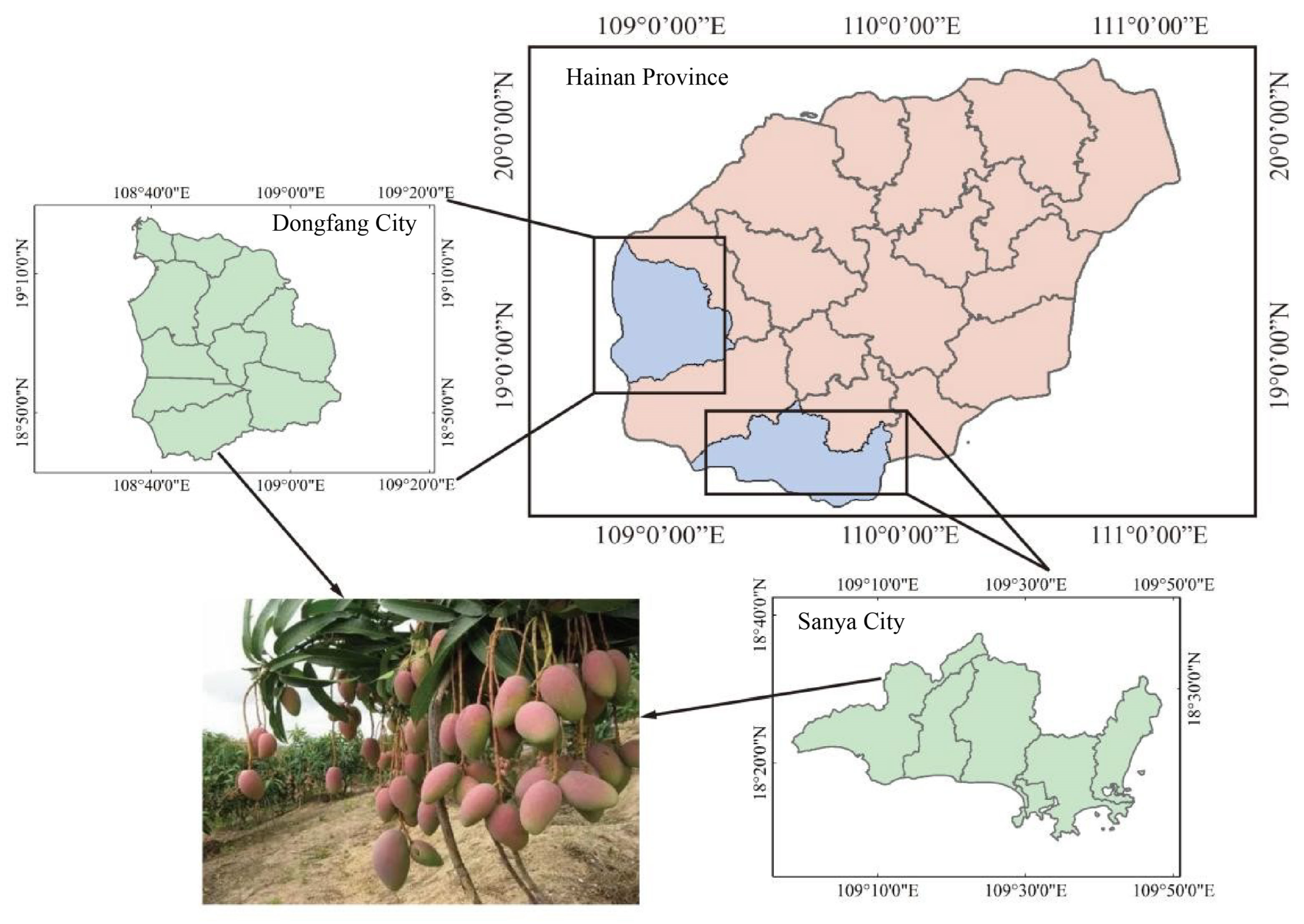
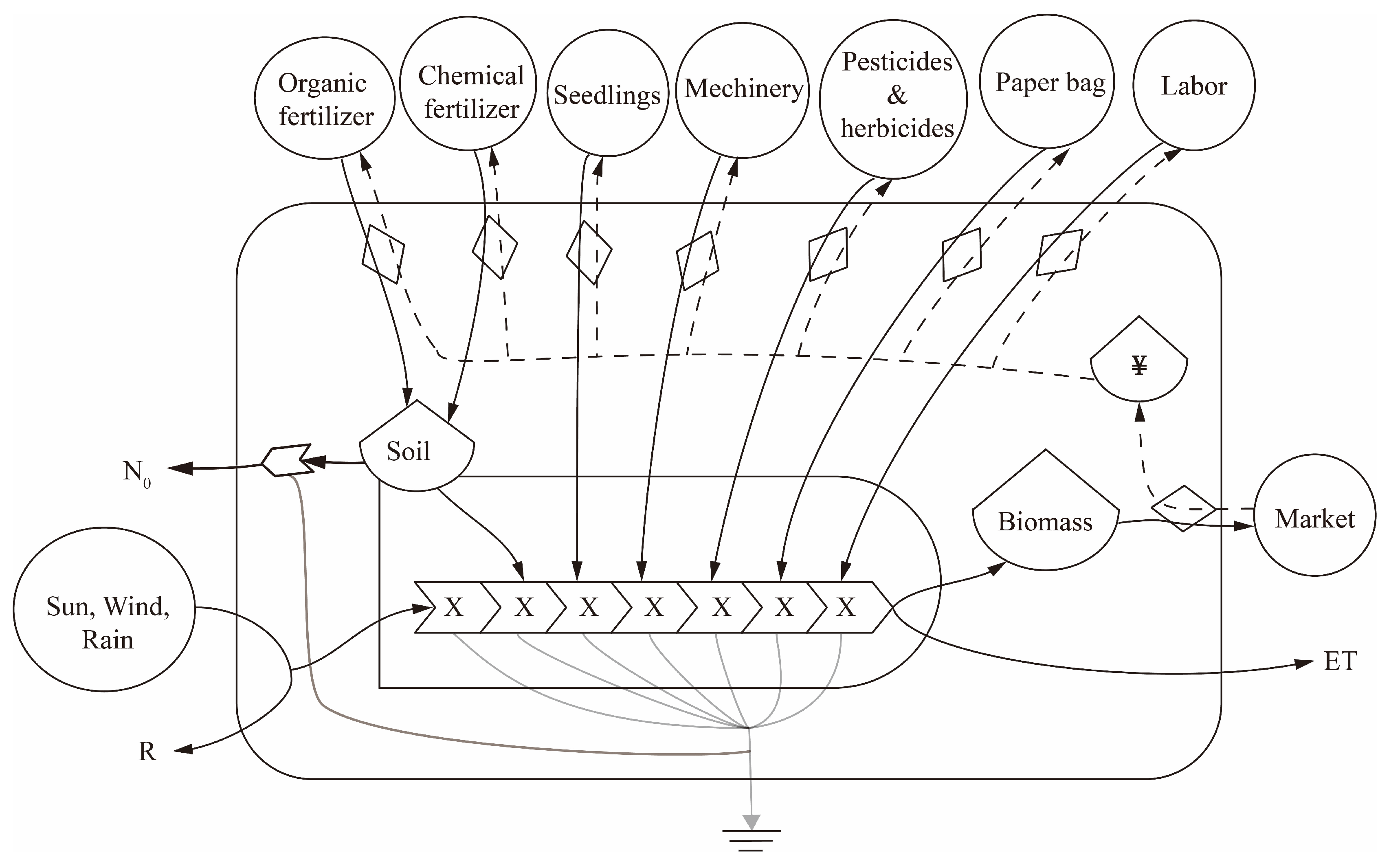
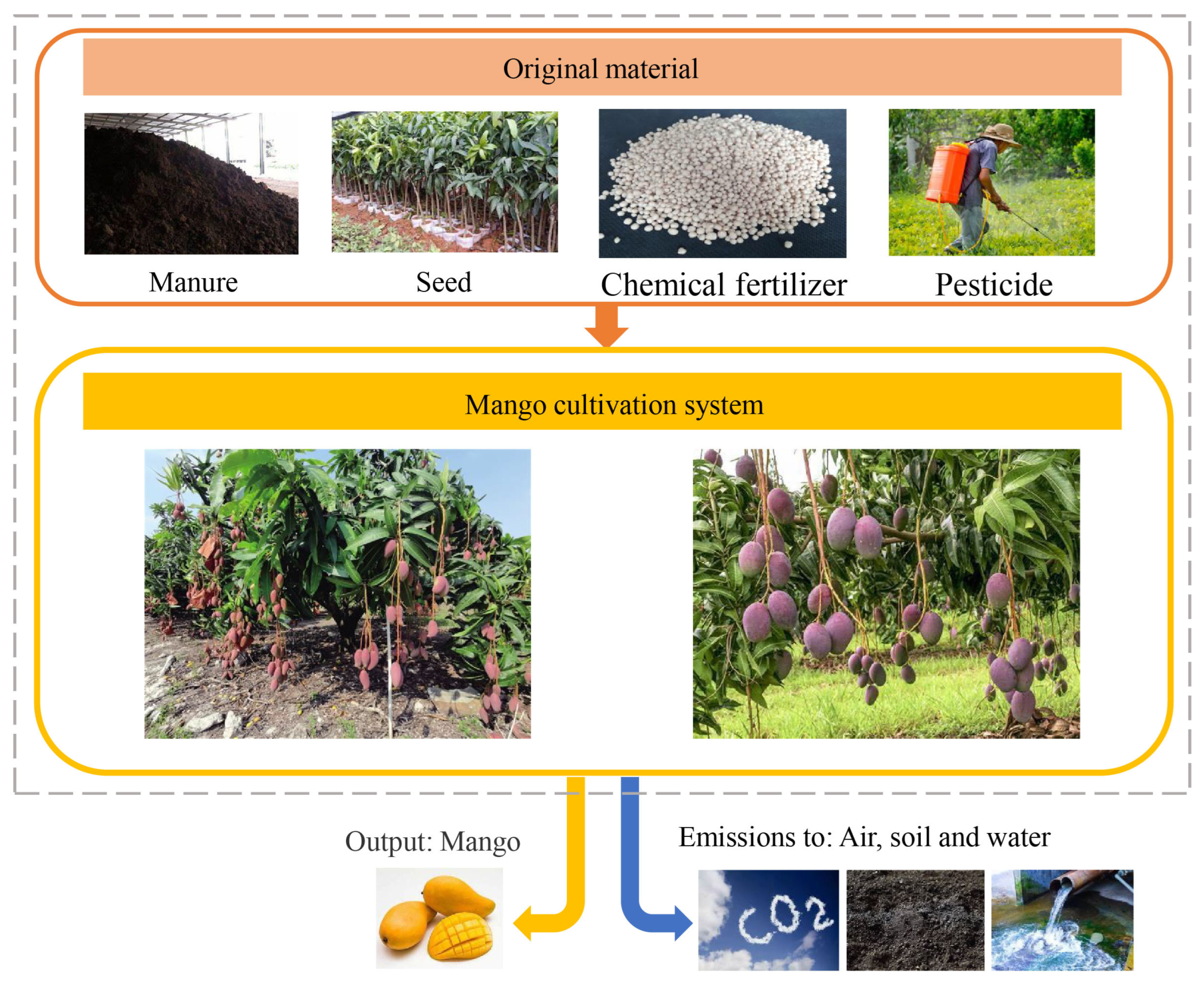
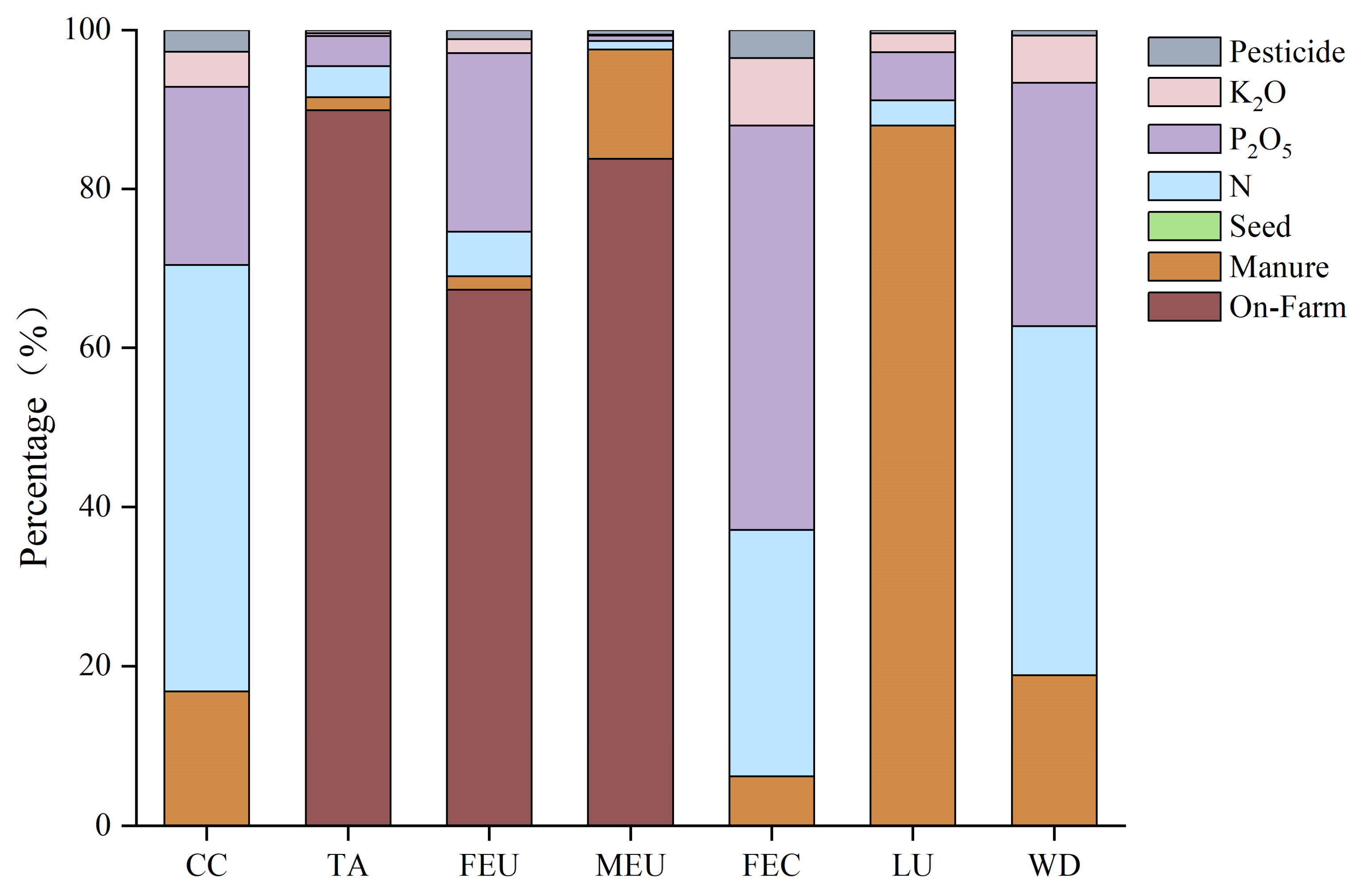
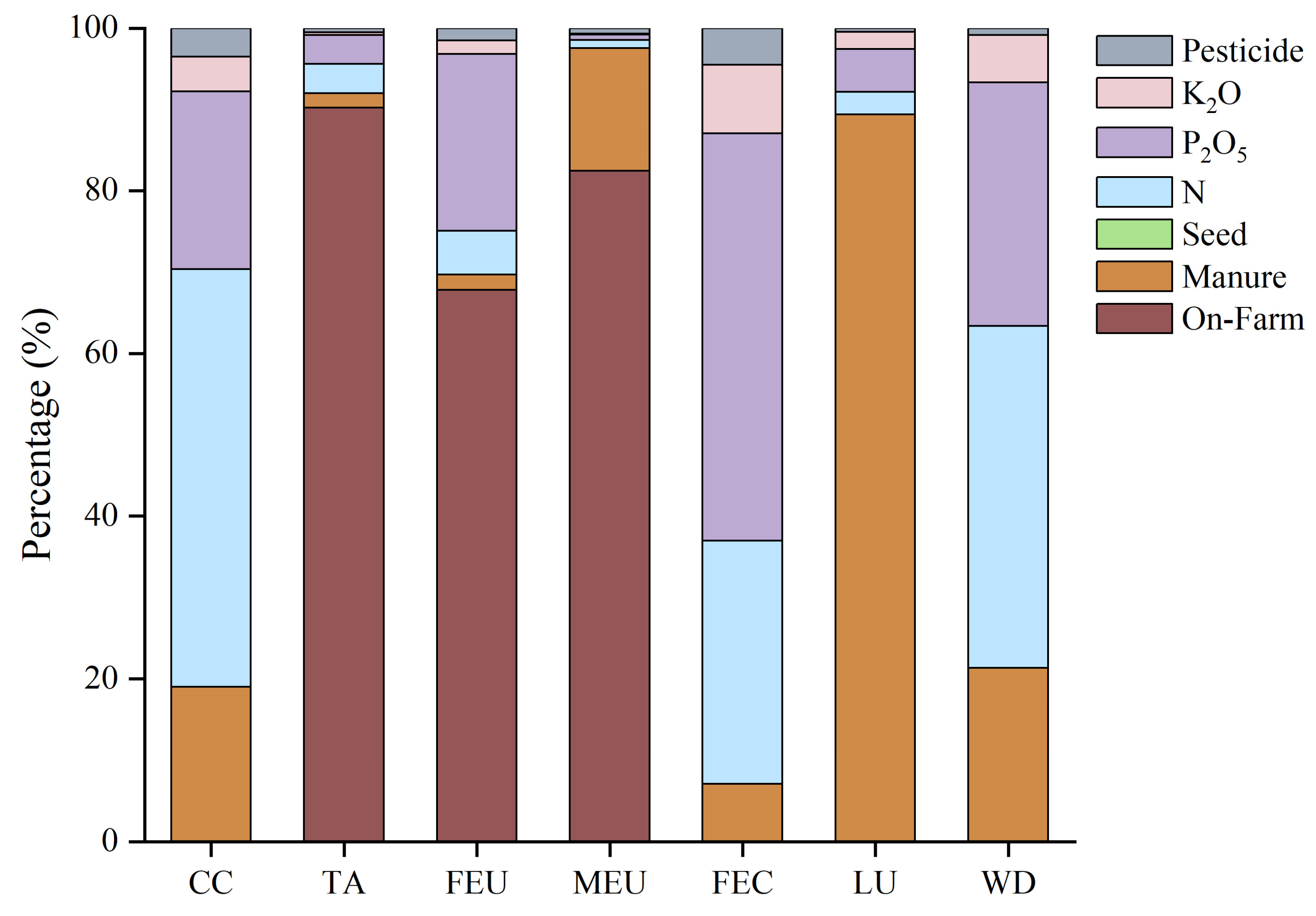
| Raw Amounts | Solar Emergy (sej) | ||||||
|---|---|---|---|---|---|---|---|
| Unit | Ren. Factor | Emergy Unit−1 | TM | EM | TM | EM | |
| Renewable environmental inputs (R) | |||||||
| Solar energy | J | 1 | 1 | 5.31 × 1013 | 5.30 × 1013 | 5.31 × 1013 | 5.30 × 1013 |
| Wind, kinetic energy | J | 1 | 1.86 × 103 | 3.15 × 1010 | 1.23 × 1010 | 5.86 × 1013 | 2.30 × 1013 |
| Rain, chemical | J | 1 | 2.25 × 104 | 5.21 × 1010 | 6.06 × 1010 | 1.17 × 1015 | 1.36 × 1015 |
| Non-renewable environmental inputs (N0) | |||||||
| Soil organic matter reduction | J | 0 | 9.36 × 104 | 4.43 × 109 | 5.06 × 109 | 4.15 × 1014 | 4.74 × 1014 |
| Purchased inputs (P) | |||||||
| Human labor | J | 0.1 | 3.80 × 106 | 8.15 × 108 | 1.02 × 109 | 3.10 × 1015 | 3.87 × 1015 |
| Manure | g | 0.8 | 2.70 × 106 | 1.50 × 107 | 1.73 × 107 | 4.05 × 1013 | 4.66 × 1013 |
| Seed | J | 0.25 | 3.49 × 104 | 6.09 × 105 | 6.09 × 105 | 2.13 × 1010 | 2.13 × 1010 |
| N | g | 0 | 4.62 × 109 | 2.14 × 105 | 2.09 × 105 | 9.88 × 1014 | 9.67 × 1014 |
| P2O5 | g | 0 | 1.78 × 1010 | 2.25 × 105 | 2.24 × 105 | 4.00 × 1015 | 3.98 × 1015 |
| K2O | g | 0 | 2.69 × 109 | 2.25 × 105 | 2.24 × 105 | 6.05 × 1014 | 6.03 × 1014 |
| Pesticide | g | 0 | 1.62 × 109 | 6.15 × 103 | 8.00 × 103 | 9.96 × 1012 | 1.30 × 1013 |
| Machine | g | 0 | 7.50 × 107 | 4.49 × 101 | 5.84 × 101 | 3.37 × 109 | 4.38 × 109 |
| Paper bag | ¥ | 0 | 5.88 × 1012 | 4.62 × 102 | 3.93 × 102 | 2.72 × 1015 | 2.31 × 1015 |
| Total output | |||||||
| Mango | J | 5.45 × 1010 | 3.63 × 1010 | ||||
| Emergy Indices | Formula | Implication |
|---|---|---|
| Transformity (sej J−1) | UEV = U/Output | It is the ratio of the emergy required to make a product or service to the available energy |
| Emergy Renewability | %R = (R + FR)/U × 100 | This indicator quantifies the reliance of each system on renewable energies. |
| Emergy Yield Ratio | EYR = U/(FN + FR) | Indicates the ability of the system to use local resources |
| Emergy Investment Ratio | EIR = (FN + FR)/(R + N0) | The ratio of externally purchased energy resources to all free environmental energy in the local system |
| Emergy Exchange Ratio | EER = U/YM | Markets exchange fair energy |
| Environmental Loading Ratio | ELR = (FN + N0 + FR)/R | The environmental load caused by the production process |
| Environmental Sustainability Index | ESI = (EYR/ELR) | The greater the dependence of the system’s output on the environment, the stronger the sustainability of the system |
| Environmental Index of Sustainable Development | EISD = EYR × EER/ELR | Consider the sustainability of economic benefits and environmental pressures |
| Emergy Index of Agricultural Product Safety | EIPS = 1 − [C ÷ (FN + FR)] | It assesses the impact of the use of fertilizers, pesticides, and herbicides on product safety |
| TM | EM | |
|---|---|---|
| UEV | 2.42 ×105 | 2.96 × 105 |
| %R | 12.37% | 13.60% |
| EYR | 1.148 | 1.162 |
| EIR | 6.740 | 6.162 |
| EER | 8.845 | 12.627 |
| ELR | 9.238 | 8.519 |
| ESI | 0.124 | 0.136 |
| EISD | 1.099 | 1.723 |
| EIPS | 0.511 | 0.528 |
| Impact Categories | Unit | FU = 1 ha | FU = 1 kg | ||
|---|---|---|---|---|---|
| TM | EM | TM | EM | ||
| CC | kg CO2 eq | 2401.42 | 2450.33 | 0.15 | 0.17 |
| TA | kg SO2 eq | 112.7 | 119.45 | 6.83 × 10−3 | 8.51 × 10−3 |
| FEU | kg P eq | 3.21 | 3.29 | 1.94 × 10−4 | 2.34 × 10−4 |
| MEU | kg N eq | 3.39 | 3.57 | 2.06 × 10−4 | 2.55 × 10−4 |
| FEC | kg 1,4-DCB | 81.67 | 82.51 | 4.95 × 10−3 | 5.87 × 10−3 |
| LU | m2a crop eq | 309.42 | 351.19 | 1.87 × 10−2 | 2.50 × 10−2 |
| WD | m3 | 36.98 | 37.68 | 2.24 × 10−3 | 2.68 × 10−3 |
| FU = 1 ha (RMB ha−1) | FU = 1 kg (RMB kg−1) | |||
|---|---|---|---|---|
| TM | EM | TM | EM | |
| Cost | 2.23 × 104 | 2.54 × 104 | 1.35 | 1.81 |
| Income | 1.32 × 105 | 1.96 × 105 | 8.00 | 14.00 |
| Profit | 1.10 × 105 | 1.71 × 105 | 6.65 | 12.19 |
| Cost–benefit ratio | 4.92 | 6.74 | 4.92 | 6.74 |
Disclaimer/Publisher’s Note: The statements, opinions and data contained in all publications are solely those of the individual author(s) and contributor(s) and not of MDPI and/or the editor(s). MDPI and/or the editor(s) disclaim responsibility for any injury to people or property resulting from any ideas, methods, instructions or products referred to in the content. |
© 2025 by the authors. Licensee MDPI, Basel, Switzerland. This article is an open access article distributed under the terms and conditions of the Creative Commons Attribution (CC BY) license (https://creativecommons.org/licenses/by/4.0/).
Share and Cite
Lei, Y.; Zhou, X.; Cheng, H. Assessment of Emergy, Environmental and Economic Sustainability of the Mango Orchard Production System in Hainan, China. Sustainability 2025, 17, 7030. https://doi.org/10.3390/su17157030
Lei Y, Zhou X, Cheng H. Assessment of Emergy, Environmental and Economic Sustainability of the Mango Orchard Production System in Hainan, China. Sustainability. 2025; 17(15):7030. https://doi.org/10.3390/su17157030
Chicago/Turabian StyleLei, Yali, Xiaohui Zhou, and Hanting Cheng. 2025. "Assessment of Emergy, Environmental and Economic Sustainability of the Mango Orchard Production System in Hainan, China" Sustainability 17, no. 15: 7030. https://doi.org/10.3390/su17157030
APA StyleLei, Y., Zhou, X., & Cheng, H. (2025). Assessment of Emergy, Environmental and Economic Sustainability of the Mango Orchard Production System in Hainan, China. Sustainability, 17(15), 7030. https://doi.org/10.3390/su17157030






